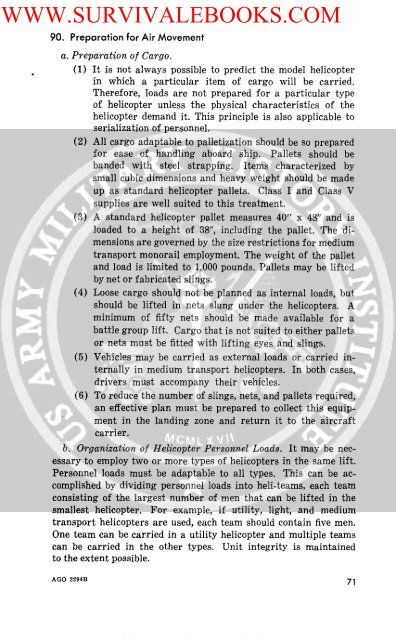FM 57-35 Airmobile Operations - Survival Books
FM 57-35 Airmobile Operations - Survival Books
FM 57-35 Airmobile Operations - Survival Books
- No tags were found...
Create successful ePaper yourself
Turn your PDF publications into a flip-book with our unique Google optimized e-Paper software.
WWW.SURVIVALEBOOKS.COM90. Preparation for Air Movementa. Preparation of Cargo.(1) It is not always possible to predict the model helicopterin which a particular item of cargo will be carried.Therefore, loads are not prepared for a particular typeof helicopter unless the physical characteristics of thehelicopter demand it. This principle is also applicable toserialization of personnel.(2) All cargo adaptable to palletization should be so preparedfor ease of handling aboard ship. Pallets should bebanded with steel strapping. Items characterized bysmall cubic dimensions and heavy weight should be madeup as standard helicopter pallets. Class I and Class Vsupplies are well suited to this treatment.(3) A standard helicopter pallet measures 40" x 48" and isloaded to a height of 38", including the pallet. The dimensions are governed by the size restrictions for mediumtransport monorail employment. The weight of the palletand load is limited to 1,000 pounds. Pallets may be liftedby net or fabricated slings.(4) Loose cargo should not be planned as internal loads, butshould be lifted in nets slung under the helicopters. Aminimum of fifty nets should be made available for abattle group lift. Cargo that is not suited to either palletsor nets must be fitted with lifting eyes and slings.(5) Vehicles may be carried as external loads or carried internally in medium transport helicopters. In both cases,drivers must accompany their vehicles.(6) To reduce the number of slings, nets, and pallets required,an effective plan must be prepared to collect this equipment in the landing zone and return it to the aircraftcarrier.b. Organization of Helicopter Personnel Loads. It may be necessary to employ two or more types of helicopters in the same lift.Personnel loads must be adaptable to all types. This can be accomplished by dividing personnel loads into heli-teams, each teamconsisting of the largest number of men that can be lifted in thesmallest helicopter. For example, if utility, light, and mediumtransport helicopters are used, each team should contain five men.One team can be carried in a utility helicopter and multiple teamscan be carried in the other types. Unit integrity is maintainedto the extent possible.AGO 2294B 71
















